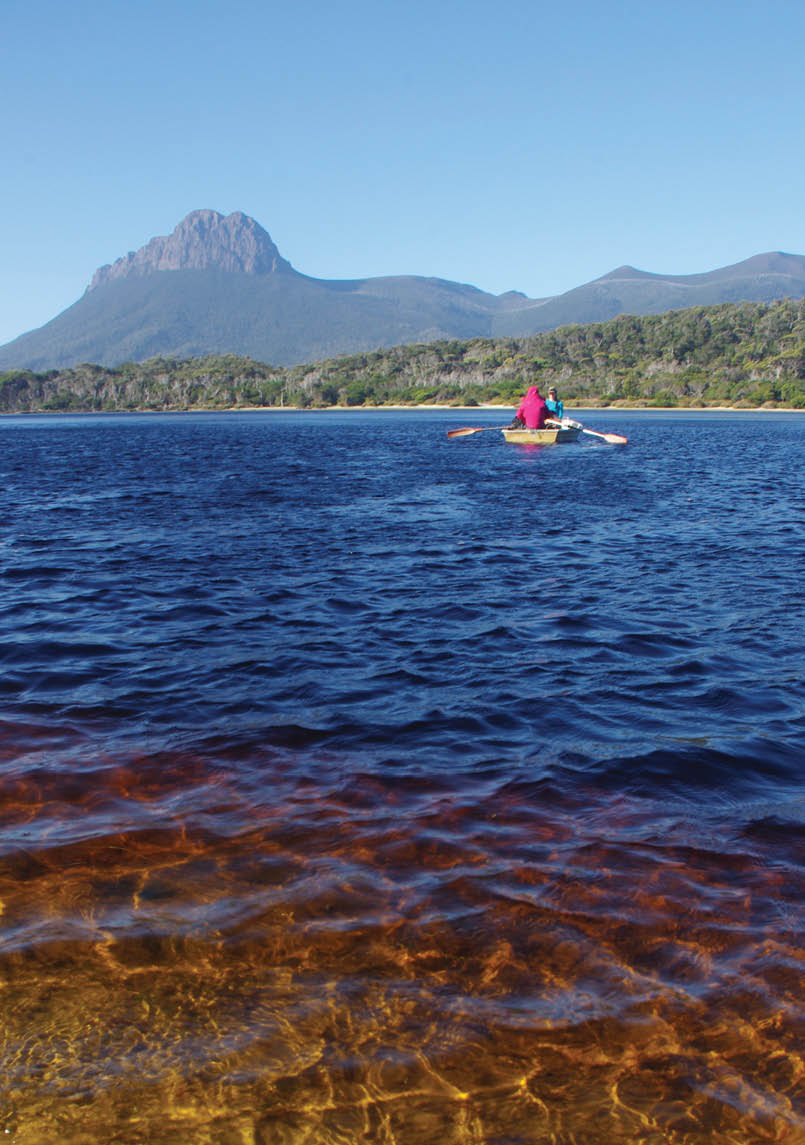
South Coast Track AdventureMelinda Ham
Watching my every foothold, I place my hiking boot gingerly in the gnarled grasp of a root. I’m keen not to twist an ankle with a 17 kilogram pack on my back on the treacherously slippery track, in sheeting rain, as I make the slow 900 metre descent down the Ironbound Range.
Melinda and Jasmine on New River LagoonMike Hall
50 | BWA December 2015
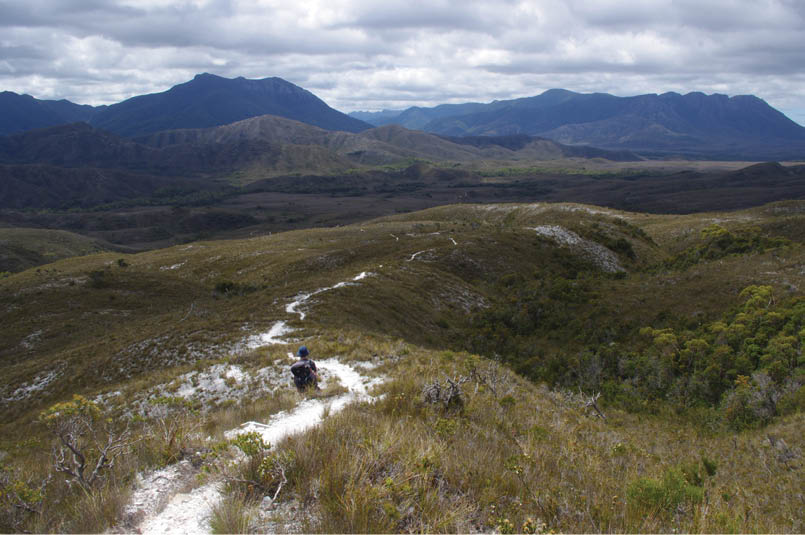
It’s day three of our eight day family hike on the 85 kilometre South Coast Track (SCT) in Tasmania’s south-west. As it turns out, this is the most challenging day of them all, with the coldest and wettest weather.
The SCT is a continuous path through the Southwest National Park from Melaleuca to Cockle Creek, 148 kilometres by road south of Hobart. The track was first marked by explorers William Tyler and William Harper in 1906 and cut in 1915, and traverses one of the world’s largest and last remaining temperate wilderness areas.
Our journey takes us through button grass plains dotted with meadows of wildflowers, where we see boronia, tea-tree and purple fairies’ aprons, across wave-pummelled beaches, forests of centuries-old Huon pine, stringy bark and other eucalypts and crosses two mountain ranges.
As we descend from the Ironbounds, through breaks in the racing storm clouds we catch glimpses of the ocean below; we imagining one montage of rocks and trees is a majestic lion stretched out, admiring the views.
Three days ago we left Hobart behind and boarded a 10-seater Britten-Norman Islander prop plane which took us on a
45 minutes flight to the beginning of the track at Melaleuca. The other ways to get to Melaleuca are by boat or the Port Davey Track.
Brushing shoulders with the mountains, the plane headed over patch-worked farmlands to the little gravel landing strip. Charles Denison “Deny” King AM, a tin miner and ornithologist, built the strip. For half a century Deny lived at Melaleuca, first with his father Charlie, then with his wife and daughters and finally for 24 years on his own.
Deny King is remembered for saving the environment of the critically-endangered Orange-bellied Parrot and allowing easier access for bushwalkers and people seeking solitude. Just before we get on the track, we duck into a hide erected in his memory and are fortunate to see two of these birds, of which only 40 remain in the wild.
This adventure is our annual luxury family holiday; luxury because the privacy, the solitude, the wilderness and togetherness are all such rare commodities in our frantically busy urban lives.
We left all phones and devices in Hobart (except for one camera and a Personal Locator Beacon that we hope we never
Harry with the view of the Ironbound Range in the backgroundMelinda Ham
BWA December 2015 | 51
have to use) and we immerse ourselves in the wilderness and a solid week of being together with no distractions.
And we also revel in our self-sufficiency. Everything we need, we carry on our backs: clothes, sleeping bags, tents, stove, food and water. Every item is meticulously weighed and reconsidered several times by the whole family before we go, so that we take the bare minimum whilst also considering safety.
On day four we set off later than the two other groups of hikers, and so after some fairly muddy sections, have the whole four kilometre long Prion Beach to ourselves; to skinny dip in the icy waves and walk along the seemingly endless beach.
We see a washed-up squid with its tentacles trailing behind. Further on a bloated bulging-eyed puffer fish with its sharp barbs smiles up at us, then later my daughter Jasmine finds just the bottom half of a Fairy penguin, reminders that we are sharing this wilderness with other creatures.
Prion Beach also has a huge overhang with a carbon-charred roof and a midden of discarded shells, more evidence that we are not the first travellers here and others have visited for more than 40,000 years.
At the end of the beach, we have the boat crossing across New River Lagoon, where first my son Harry rows Jasmine and I and our gear across and then goes back for my husband Mike as the wind tries to blow them
off course. One boat is left at each side. At the next campsite beneath the trees a curious tubby pademelon and her little joey pay us a visit.
On day five we spend much of our time in a stringy bark and peppermint forest, marvelling at the age and beauty of the towering trees above us and imagine what living for two hundred years must be like, hoping some of their wisdom and longevity will brush off on us. Some trees have fallen like gargantuan dinosaur carcasses across our path and we clamber over them to continue on our way.
How any individual, company, state government or federal government could even consider killing these majestic kings of the forest that have taken two centuries to reach their lofty heights leaves us all completely speechless.
We climb the cliff from Surprise Bay up to the best campsite of the track, with sweeping views that gives us an instant recap of our journey, mountain ranges, towering forests, undulating coves and beaches. The bruised sunset sky convinces us to spend a rest day here.
For most of our trip we’ve tramped alone as a family and here again, we initially have the site to ourselves. But in the afternoon of the next day Lars, a lone Swiss-German teenager appears. He pulls out half a wheel of Camembert, fresh cucumber and
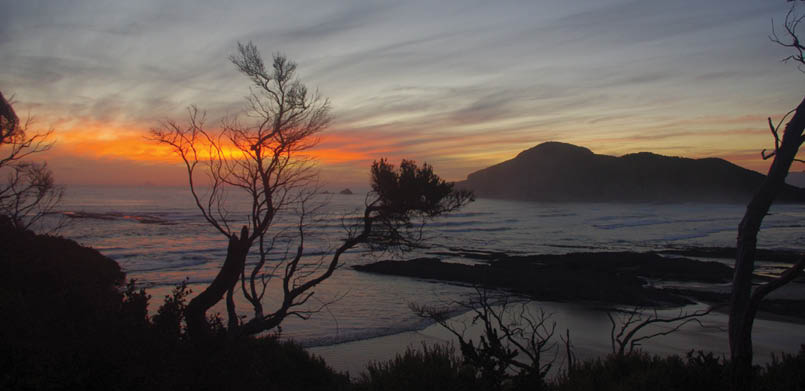
Surprise Beach sunsetHarry Hall
52 | BWA December 2015
tomatoes, which he enjoys while the rest of us visibly salivate as we eat our reconstituted freeze dry dinners.
Then Rodney, a 65-year-old indigenous man who’s done the track nearly a dozen times before appears with two young companions. We all swapped tales; although much of Rodney’s toasty-dry Aussie humour gets lost in translation and goes right over Lars’ head.
On day seven we head out along Granite Beach, where the ocean continuously rolling in and out, has rounded the boulders and makes a soothing, percussive clacking sound. In the notorious Roaring Forties latitudes 100 kilometre an hour winds are not uncommon.
After a strenuous climb up the South Cape Range, we camp and swim in the tannin-stained waters of the creek; Harry and I have a pact to swim everyday on the track.
It’s the final day, so we bid the ocean farewell and head inland to a busy holiday weekend. Encountering a few day-trippers on the track, by the time we reach Cockle Creek campsite we are overrun with cars and campervans for the first time in a week. Back to reality, but our hearts and minds still consumed with our luxurious holiday.
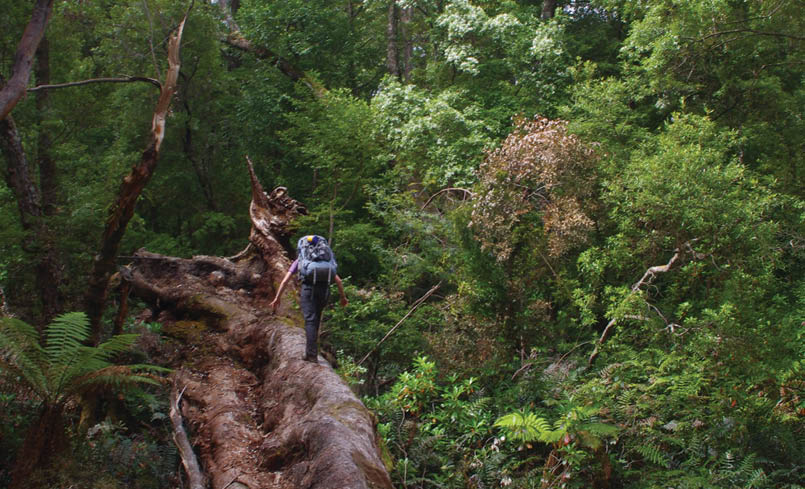
Melinda, her patient husband, teenage son and teenage daughter are passionate multi-day hikers. Originally from Canada, Melinda used to revel in summer canoeing. After moving to Australia 20 years ago she fell in love with the unique Australian bush. Her family have hiked around Mt Kosciuszko, completed the Overland Track, walked the Wilderness Coast in southern Victoria, the Yuraygir Coastal Walk in northern NSW and “done the Dusky” in New Zealand’s Fiordland. Melinda lives on Scotland Island in Sydney and enjoys day hikes in Ku-ring-gai National Park, especially in wildflower season. She is a professional journalist and editor. See melindaham.com.au
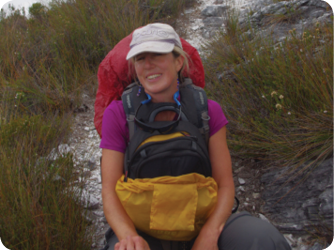
Jasmine in Huon pine forestMelinda Ham
BWA December 2015 | 53